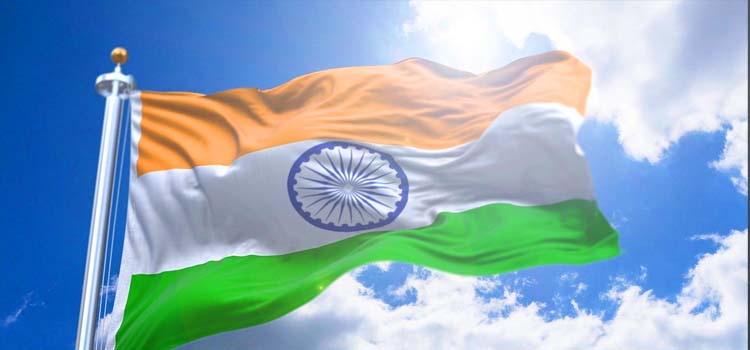National Flag Code of India: Know Your Tiranga
Posted On : August 11, 2022

Table of Contents
Independence was a great deal for India in 1947 when we got back the steering wheel of our own land. It was time to re-establish our identity as a nation. Having a national flag of India was a massive decision which had already witnessed several changes during the struggle for freedom. It went from bright colors like red, yellow, having the sun and moon, then red and green stripes in the presence of the British flag, thereby settling with a tricolored flag with a huge spinning wheel (Charkha) covering all three colors. At last in 1931, we got current tricolors, i.e. saffron, white and green with a Charkha over the white band which was designed by the freedom fighter Pingali Venkayya.
However, in 1947 when we were finally attaining independence, the Charkha also got replaced with the depiction of Dharmachakra, i.e. Ashok Chakra. It was on 22 July, 1947 that we got the tricolor flag of India - Tiranga with saffron, white and green panels and a navy blue Ashok Chakra at the centre. Respecting the Indian flag is an obligation of every Indian citizen. To make things clear, Flag Code of India, 2002 contains rules regarding the display of the national flag.
The central government is campaigning for ‘Har Ghar Tiranga’ on the auspicious occasion of India’s 75th Independence Day celebration - Aazadi ka Amrit Mahotsav. More than 20 crore Indian homes are preparing for hoisting of national flag between August 13 - 15, 2022. Due to this, it becomes crucial for Indian citizens to know the Flag Code of India, 2002. Find details on Indian flag rules and regulations in the blog below applicable to the general public.
Look and Feel of Indian Flag
Part 1 of the Flag Code of India, 2002 mainly focuses upon what the national flag of India shall look like. The pointers below explain the specifications in the Indian flag as mentioned in the Code:
- Our flag is made up of hand spun and hand woven material - Wool/cotton/polyester/machine made/silk khadi bunting
- Length to height ratio - 3:2
- Tricolour panel with 3 rectangular sub-panels
- All 3 sub-panels shall have the equal width
- Top panel - India saffron/ Kesari
- Mid panel - White with navy blue coloured Ashok Chakra at the centre having 24 equidistant spokes
- Bottom panel - India green
- Ashok Chakra at the centre may be printed/ screen printed/ stencilled/ embroidered and has to be completely visible on both sides of the Indian flag
Indian Flag - Standard Dimensions
|
Flag Size |
Dimensions (mm) |
Intended Use |
|
1 |
6300 X 4200 |
Display |
|
2 |
3600 X 2400 |
|
|
3 |
2700 X 1800 |
|
|
4 |
1800 X 1200 |
|
|
5 |
1350 X 900 |
|
|
6 |
900 X 600 |
|
|
7 |
450 X 300 |
Aircrafts on VVIP Flights |
|
8 |
225 X 150 |
Motor Cars |
|
9 |
150 X 100 |
Table Flags |
What are the Rules of National Flag?
Part 2 of the National Flag Code, 2002 provides for the rules regarding the display of the national flag. There is no restriction over the display of the national flag of India by the general public, educational institutes, state or central governments, etc., when basic rules are followed.
However, use of Indian flag is restricted for the following purposes:
- For commercial purposes - trade, business, calling or profession
- Title of a patent
- Design trademark
- Any similar imitation without permission from central government or suitable authority
- Not be dipped during salute to any person or thing
Indian Flag Rules and Regulations
- The national flag of India should always occupy a position of honour and distinction.
- Rules regarding the display of the national flag prohibit use of a damaged or dishevelled tricolor flag.
- When displayed horizontally, saffron band should be on the upper most. While being displayed vertically, saffron band should be on the right as per Flag Code of India, 2002.
- Use of Indian flag as a festoon, rosette or bunting or for any decorative purposes is prohibited.
- Waving Indian tricolor flag on national celebrations is allowed, but the same should not be thrown or discarded.
- Burning, mutilating, defacing, defiling, disfiguring, destroying, trampling upon or bringing contempt through words of the Indian national flag in public view is punishable with imprisonment upto 3 years or fine or both.
- Rules regarding the display of the national flag prohibit an inverted Tiranga with saffron on the downside.
- Indian flag flown at half mast is not allowed except on special occasions as instructed by the government.
- Tricolor flag of India can not be draped in any way including private funerals.
- Wearing the Indian flag as part of a costume or uniform is also prohibited.
- Tiranga printed or embroidered on cushions, handkerchiefs, napkins or any dress material is also restricted.
- The Indian tricolor flag can not be used for delivering, carrying or holding anything except flower petals before hoisting of national flag during celebrations.
- Tiranga should not be intentionally touching the floor or trail in water.
- Use of Tiranga to drape an unveiling statue, building, or draped over the top, sides, hood, etc. of a transport vehicle is prohibited.
- When the national flag of India is in soiled or damaged condition, it should be destroyed as a whole in private with dignity by burning or any other method.
Recent Changes in Indian Flag Rules and Regulations
On the auspicious occasion of India’s 75th Independence Day, the government of India is campaigning for ‘Har Ghar Tiranga’ initiative. Hence, some changes in the existing Flag Code of India were need of the hour. While one amendment was introduced in December 2021, the other was enforced in July 2022.
- Flags made of polyester or machine made flags are allowed
- Indian flag can be hoisted at night as well if displayed in the open or on the house
The government under ‘Har Ghar Tiranga’ campaign aims at around 20 crores homes in India hoisting the national flag of India between August 13-15, 2022.
FAQs Regarding Rules for Tricolor Flag of India
Q- Who designed the national flag?
A- Pingali Venkayya, an Indian freedom fighter was the designer of the Indian tricolor flag that we all look upto with respect. The original design by Venkayya had all the three colours, i.e. saffron, white and green. The only difference between the present national flag and the one designed by him was that it included a Charkha (spinning wheel) on the white panel. However, it was replaced by the current Ashok Chakra to acknowledge the Lion capital of Ashoka from glorious Indian history.
Q- When was the Flag Code of India established?
A- Flag Code of India came into existence in 2002 assimilating the provisions of various laws like Emblems and Names (Prevention of Improper Use) Act, 1950 and The Prevention of Insults to National Honour Act, 1971.
Q- Where can the national flag be hoisted?
A- Generally, the Indian flag should be hoisted on buildings of national importance and government offices. However, hoisting of national flag is not restricted otherwise, provided that it is flown at a distinct and respectable position and all other obligations are duly followed in the honour of Tiranga.
Q- Can we hoist Indian flag with shoes?
A- The Flag Code of India does not restrict hoisting of the national flag with shoes on. Hence, one can not be booked for hoisting Indian flag while wearing shoes and it is not a disrespectful gesture. However, since Indian culture involves keeping footwear outside the place of religion and revered sentiments are connected with the Indian tricolour flag, it is good to show respect by removing your shoes before hoisting Indian flag.
Q- Can children hoist flags?
A- Yes, hoisting national flag of India by children is not prohibited but highly appreciated. Unless some disrespectful act is done, anyone can hoist the Tiranga. In fact, national days like Republic Day (January 26) and Independence Day (August 15) are an inescapable celebration in the educational institutes. Activities like these hold gravity in entailing national values in the budding citizens of India.
Q- What are the do's and don'ts of flag hoisting time?
A- Earlier, hoisting Indian flag was allowed specifically between sunrise and sunset. However, with the recent amendment to Flag Code of India, 2002, tricolor flag of India can be hoisted at night as well, provided that the area is illuminated enough for the flag to be visible.
























